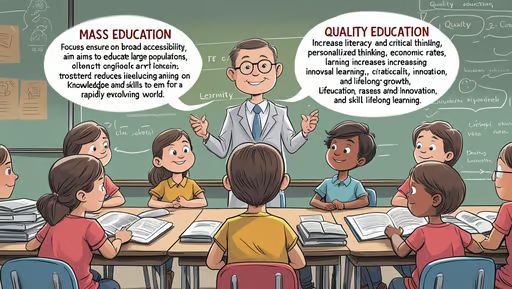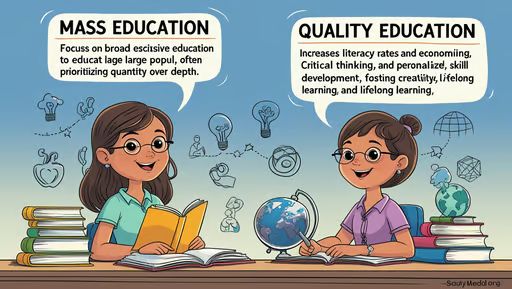Mass Education vs. Quality Education, Education is the cornerstone of human development and societal progress. It empowers individuals, fosters innovation, and drives economic growth. However, the global education system faces a critical dilemma: the tension between mass education and quality education. While mass education aims to provide access to learning for all, quality education focuses on delivering meaningful, effective, and transformative learning experiences. This article explores the differences between mass education and quality education, the challenges associated with each, and the need to strike a balance between the two to ensure sustainable development.
Understanding Mass Education
Mass education refers to the widespread provision of educational opportunities to a large population. It emphasizes accessibility, inclusivity, and the democratization of learning. The goal of mass education is to ensure that every individual, regardless of their socioeconomic background, has the opportunity to attend school and acquire basic literacy and numeracy skills.
The concept of mass education gained prominence during the Industrial Revolution, when societies recognized the need for an educated workforce to support economic growth. In the 20th century, the Universal Declaration of Human Rights (1948) further reinforced the idea that education is a fundamental right, leading to global efforts to expand access to schooling. Initiatives such as the United Nations’ Millennium Development Goals (MDGs) and Sustainable Development Goals (SDGs) have prioritized universal primary education, resulting in significant progress in enrollment rates worldwide.
Advantages of Mass Education
- Increased Literacy Rates: Mass education has played a pivotal role in reducing illiteracy and empowering individuals with basic skills.
- Social Equity: By providing education to marginalized groups, mass education helps bridge social and economic gaps.
- Economic Growth: A more educated population contributes to higher productivity and innovation, driving economic development.
- Global Connectivity: Mass education fosters a shared knowledge base, enabling better communication and collaboration across cultures.
Challenges of Mass Education
- Overcrowded Classrooms: Rapid expansion of education systems often leads to overcrowded classrooms, making it difficult for teachers to provide individual attention.
- Resource Constraints: Many countries struggle to allocate sufficient resources, resulting in inadequate infrastructure, outdated materials, and underpaid teachers.
- Standardization: Mass education often relies on standardized curricula and assessments, which may not cater to the diverse needs and talents of students.
- Quality Compromise: The focus on quantity can sometimes overshadow the importance of quality, leading to superficial learning outcomes.

Understanding Quality Education
Quality education goes beyond mere access to schooling. It emphasizes the delivery of meaningful, relevant, and effective learning experiences that equip students with the knowledge, skills, and values needed to thrive in a rapidly changing world. Quality education is characterized by well-trained teachers, engaging curricula, inclusive practices, and supportive learning environments.
The United Nations Educational, Scientific and Cultural Organization (UNESCO) defines quality education as one that addresses the cognitive, emotional, and social development of learners. It prioritizes critical thinking, creativity, and problem-solving skills over rote memorization. Quality education also promotes equity, ensuring that all students, regardless of their background, have the opportunity to succeed.
Advantages of Quality Education
- Holistic Development: Quality education nurtures not only academic skills but also emotional intelligence, creativity, and ethical values.
- Lifelong Learning: It instills a love for learning and equips students with the ability to adapt to new challenges throughout their lives.
- Economic and Social Benefits: High-quality education leads to better job prospects, higher incomes, and improved social outcomes.
- Innovation and Progress: Quality education fosters innovation by encouraging curiosity, experimentation, and critical thinking.
Challenges of Quality Education
- High Costs: Delivering quality education requires significant investment in infrastructure, teacher training, and resources, which may be unaffordable for many countries.
- Inequality: Disparities in access to quality education often exacerbate existing social and economic inequalities.
- Resistance to Change: Traditional education systems may resist reforms needed to implement quality education practices.
- Measurement Difficulties: Assessing the quality of education is complex, as it involves subjective factors such as student engagement and teacher effectiveness.
The Tension Between Mass Education and Quality Education
The tension between mass education and quality education arises from the competing priorities of scale and depth. While mass education focuses on expanding access, quality education emphasizes the depth and effectiveness of learning. This tension is particularly evident in developing countries, where limited resources force policymakers to make difficult trade-offs.
For instance, a government may prioritize building more schools to accommodate a growing student population, but this could come at the expense of teacher training or curriculum development. Similarly, standardized testing, often used to measure the success of mass education initiatives, may not capture the nuanced outcomes of quality education, such as critical thinking or creativity.
Striking the Balance: A Path Forward
To address the challenges of mass education and quality education, policymakers and educators must adopt a balanced approach that integrates the strengths of both models. Here are some strategies to achieve this balance:
- Invest in Teacher Training: Teachers are the backbone of any education system. Investing in their professional development can improve the quality of education while maintaining access for all.
- Leverage Technology: Digital tools and online platforms can help bridge the gap between mass and quality education by providing personalized learning experiences and reaching remote or underserved populations.
- Promote Inclusive Practices: Education systems should be designed to accommodate diverse learning needs, ensuring that no student is left behind.
- Focus on Outcomes: Rather than solely measuring enrollment rates, policymakers should prioritize learning outcomes, such as literacy, numeracy, and critical thinking skills.
- Encourage Community Involvement: Engaging parents, communities, and local organizations can create a supportive ecosystem for both mass and quality education.
- Adopt Flexible Curricula: Curricula should be adaptable to local contexts and evolving global challenges, ensuring that education remains relevant and impactful.
Case Studies: Success Stories
Several countries have successfully balanced mass education and quality education, offering valuable lessons for others:
- Finland: Known for its high-quality education system, Finland emphasizes teacher training, student well-being, and equitable access. Despite its small population, Finland consistently ranks among the top performers in international education assessments.
- South Korea: South Korea has achieved universal access to education while maintaining high standards. The country invests heavily in teacher training and technology, ensuring that students receive a world-class education.
- Rwanda: After the devastating genocide in 1994, Rwanda prioritized education as a tool for rebuilding the nation. The government has made significant strides in expanding access while improving quality through community involvement and innovative policies.
Conclusion
The debate between mass education and quality education is not about choosing one over the other but about finding a harmonious balance that maximizes the benefits of both. Mass education ensures that everyone has the opportunity to learn, while quality education ensures that learning is meaningful and transformative. By investing in teacher training, leveraging technology, and adopting inclusive practices, societies can create education systems that are both accessible and effective.
In a world facing complex challenges such as climate change, technological disruption, and social inequality, education is more important than ever. Striking the right balance between mass education and quality education is not just a matter of policy—it is a moral imperative and a pathway to a more equitable and sustainable future. As Nelson Mandela famously said, “Education is the most powerful weapon which you can use to change the world.” Let us wield this weapon wisely, ensuring that it reaches all and transforms lives for the better.

6 thoughts on “Mass Education vs. Quality Education”
Comments are closed.